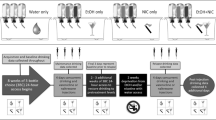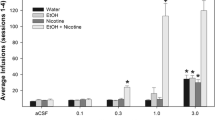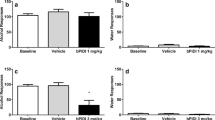Abstract
Rationale
Co-users of alcohol and nicotine are the largest group of polysubstance users worldwide. Commonalities in mechanisms of action for ethanol (EtOH) and nicotine proposes the possibility of developing a single pharmacotherapeutic to treat co-use.
Objectives
Toward developing a preclinical model of co-use, female alcohol-preferring (P) rats were trained for voluntary EtOH drinking and i.v. nicotine self-administration in three phases: (1) EtOH alone (0 vs. 15%, two-bottle choice), (2) nicotine alone (0.03 mg/kg/infusion, active vs. inactive lever), and (3) concurrent access to both EtOH and nicotine. Using this model, we examined the effects of (1) varenicline, a nicotinic acetylcholine receptor (nAChR) partial agonist with high affinity for the α4β2* subtype; (2) r-bPiDI, a subtype-selective antagonist at α6β2* nAChRs; and (3) (R)-modafinil, an atypical inhibitor of the dopamine transporter (DAT).
Results
In phases 1 and 2, pharmacologically relevant intake of EtOH and nicotine was achieved. In the concurrent access phase (phase 3), EtOH consumption decreased while nicotine intake increased relative to phases 1 and 2. For drug pretreatments, in the EtOH access phase (phase 1), (R)-modafinil (100 mg/kg) decreased EtOH consumption, with no effect on water consumption. In the concurrent access phase, varenicline (3 mg/kg), r-bPiDI (20 mg/kg), and (R)-modafinil (100 mg/kg) decreased nicotine self-administration but did not alter EtOH consumption, water consumption, or inactive lever pressing.
Conclusions
These results indicate that therapeutics which may be useful for smoking cessation via selective inhibition of α4β2* or α6β2* nAChRs, or DAT inhibition, may not be sufficient to treat EtOH and nicotine co-use.










Similar content being viewed by others
References
Alcohol Facts and Statistics. In: Alcoholism NIoAAa (ed). U.S. Department of Health and Human Services, June 2017, www.niaaa.nih.gov
Avelar AJ, Cao J, Newman AH, Beckstead MJ (2017) Atypical dopamine transporter inhibitors R-modafinil and JHW 007 differentially affect D2 autoreceptor neurotransmission and the firing rate of midbrain dopamine neurons. Neuropharmacology 123:410–419
Bardo MT, Green TA, Crooks PA, Dwoskin LP (1999) Nornicotine is self-administered intravenously by rats. Psychopharmacology 146:290–296
Barkley-Levenson AM, Crabbe JC (2014) High drinking in the dark mice: a genetic model of drinking to intoxication. Alcohol (Fayetteville, NY) 48:217–223
Beckmann JS, Meyer AC, Pivavarchyk M, Horton DB, Zheng G, Smith AM, Wooters TE, McIntosh JM, Crooks PA, Bardo MT, Dwoskin LP (2015) r-bPiDI, an alpha6beta2* nicotinic receptor antagonist, decreases nicotine-evoked dopamine release and nicotine reinforcement. Neurochem Res 40:2121–2130
de Bejczy A, Lof E, Walther L, Guterstam J, Hammarberg A, Asanovska G, Franck J, Isaksson A, Soderpalm B (2015) Varenicline for treatment of alcohol dependence: a randomized, placebo-controlled trial. Alcohol Clin Exp Res 39:2189–2199
Bell RL, Rodd ZA, Smith RJ, Toalston JE, Franklin KM, McBride WJ (2011) Modeling binge-like ethanol drinking by peri-adolescent and adult P rats. Pharmacol Biochem Behav 100:90–97
Bell RL, Sable HJ, Colombo G, Hyytia P, Rodd ZA, Lumeng L (2012) Animal models for medications development targeting alcohol abuse using selectively bred rat lines: neurobiological and pharmacological validity. Pharmacol Biochem Behav 103:119–155
Bell RL, Hauser S, Rodd ZA, Liang T, Sari Y, McClintick J, Rahman S, Engleman EA (2016) A genetic animal model of alcoholism for screening medications to treat addiction. Int Rev Neurobiol 126:179–261
Bevins RA, Caggiula AR (2009) The motivational impact of nicotine and its role in tobacco use. Springer
Carroll ME, Carmona GG, May SA (1991) Modifying drug-reinforced behavior by altering the economic conditions of the drug and a nondrug reinforcer. J Exp Anal Behav 56:361–376
Carroll MR, Rodd ZA, Murphy JM, Simon JR (2006) Chronic ethanol consumption increases dopamine uptake in the nucleus accumbens of high alcohol drinking rats. Alcohol (Fayetteville, NY) 40:103–109
Chiappetta V, Garcia-Rodriguez O, Jin CJ, Secades-Villa R, Blanco C (2014) Predictors of quit attempts and successful quit attempts among individuals with alcohol use disorders in a nationally representative sample. Drug Alcohol Depend 141:138–144
Cicero TJ, Smithloff BR (1973) Alcohol oral self-administration in rats: attempts to elicit excessive intake and dependence. Alcohol Intoxication and Withdrawal I Springer:213–224
Cippitelli A, Wu J, Gaiolini KA, Mercatelli D, Schoch J, Gorman M, Ramirez A, Ciccocioppo R, Khroyan TV, Yasuda D, Zaveri NT, Pascual C, Xie X, Toll L (2015) AT-1001: a high-affinity α3β4 nAChR ligand with novel nicotine-suppressive pharmacology. Br J Pharmacol 172:1834–1845
Corrigall WA (1992) A rodent model for nicotine self-administration. Animal models of drug addiction:315–344
Corrigall WA, Coen KM (1989) Nicotine maintains robust self-administration in rats on a limited-access schedule. Psychopharmacology 99:473–478
DeNoble VJ, Mele PC (2006) Intravenous nicotine self-administration in rats: effects of mecamylamine, hexamethonium and naloxone. Psychopharmacology 184:266–272
Donny EC, Caggiula AR, Rowell PP, Gharib MA, Maldovan V, Booth S, Mielke MM, Hoffman A, McCallum S (2000) Nicotine self-administration in rats: estrous cycle effects, sex differences and nicotinic receptor binding. Psychopharmacology 151:392–405
Ebbert JO, Croghan IT, Hurt RT, Schroeder DR, Hays JT (2016) Varenicline for smoking cessation in light smokers. Nicotine & tobacco research : official journal of the Society for Research on Nicotine and Tobacco 18:2031–2035
Ericson M, Lof E, Stomberg R, Soderpalm B (2009) The smoking cessation medication varenicline attenuates alcohol and nicotine interactions in the rat mesolimbic dopamine system. J Pharmacol Exp Ther 329:225–230
Falk DE, Yi HY, Hiller-Sturmhofel S (2006) An epidemiologic analysis of co-occurring alcohol and tobacco use and disorders: findings from the National Epidemiologic Survey on Alcohol and Related Conditions. Alcohol research & health : the journal of the National Institute on Alcohol Abuse and Alcoholism 29:162–171
Falk DE, Castle IJ, Ryan M, Fertig J, Litten RZ (2015) Moderators of varenicline treatment effects in a double-blind, placebo-controlled trial for alcohol dependence: an exploratory analysis. J Addict Med 9:296–303
Feduccia AA, Simms JA, Mill D, Yi HY, Bartlett SE (2014) Varenicline decreases ethanol intake and increases dopamine release via neuronal nicotinic acetylcholine receptors in the nucleus accumbens. Br J Pharmacol 171:3420–3431
Froehlich JC, Nicholson ER, Dilley JE, Filosa NJ, Rademacher LC, Smith TN (2017) Varenicline reduces alcohol intake during repeated cycles of alcohol reaccess following deprivation in alcohol-preferring (P) rats. Alcohol Clin Exp Res 41:1510–1517
Funk D, Lo S, Coen K, Le AD (2016) Effects of varenicline on operant self-administration of alcohol and/or nicotine in a rat model of co-abuse. Behav Brain Res 296:157–162
George O, Lloyd A, Carroll FI, Damaj MI, Koob GF (2011) Varenicline blocks nicotine intake in rats with extended access to nicotine self-administration. Psychopharmacology 213:715–722
Glick S, Visker K, Maisonneuve I (1996) An oral self-administration model of nicotine preference in rats: effects of mecamylamine. Psychopharmacology 128:426–431
Gonzales D, Rennard SI, Nides M, Oncken C, Azoulay S, Billing CB, Watsky EJ, Gong J, Williams KE, Reeves KR (2006) Varenicline, an alpha4beta2 nicotinic acetylcholine receptor partial agonist, vs sustained-release bupropion and placebo for smoking cessation: a randomized controlled trial. Jama 296:47–55
Grant KA, Bennett AJ (2003) Advances in nonhuman primate alcohol abuse and alcoholism research. Pharmacol Ther 100:235–255
Henningfield JE, Chait LD, Griffiths RR (1984) Effects of ethanol on cigarette smoking by volunteers without histories of alcoholism. Psychopharmacology 82:1–5
Jorenby DE, Hays J, Rigotti NA et al (2006) Efficacy of varenicline, an α4β2 nicotinic acetylcholine receptor partial agonist, vs placebo or sustained-release bupropion for smoking cessation: a randomized controlled trial. Jama 296:56–63
Kamens HM, Andersen J, Picciotto MR (2010) Modulation of ethanol consumption by genetic and pharmacological manipulation of nicotinic acetylcholine receptors in mice. Psychopharmacology 208:613–626
Koob GF, Kenneth Lloyd G, Mason BJ (2009) Development of pharmacotherapies for drug addiction: a Rosetta stone approach. Nat Rev Drug Discov 8:500–515
Lê AD, Li Z, Funk D, Shram M, Li TK, Shaham Y (2006) Increased vulnerability to nicotine self-administration and relapse in alcohol-naive offspring of rats selectively bred for high alcohol intake. J Neurosci : Off J Soc Neurosci 26:1872–1879
Lê AD, Lo S, Harding S, Juzytsch W, Marinelli PW, Funk D (2010) Coadministration of intravenous nicotine and oral alcohol in rats. Psychopharmacology 208:475–486
Lester D, Freed EX (1973) Criteria for an animal model of alcoholism. Pharmacol Biochem Behav 1:103–107
Levin ED, Wells C, Johnson JE, Rezvani AH, Bymaster FP, Rose JE (2015) Amitifadine, a triple monoamine re-uptake inhibitor, reduces nicotine self-administration in female rats. Eur J Pharmacol 764:30–37
Litten RZ, Ryan ML, Fertig JB, Falk DE, Johnson B, Dunn KE, Green AI, Pettinati HM, Ciraulo DA, Sarid-Segal O, Kampman K, Brunette MF, Strain EC, Tiouririne NA, Ransom J, Scott C, Stout R (2013) A double-blind, placebo-controlled trial assessing the efficacy of varenicline tartrate for alcohol dependence. J Addict Med 7:277–286
Mayfield RD, Maiya R, Keller D, Zahniser NR (2001) Ethanol potentiates the function of the human dopamine transporter expressed in Xenopus oocytes. J Neurochem 79:1070–1079
McBride WJ, Rodd ZA, Bell RL, Lumeng L, Li TK (2014) The alcohol-preferring (P) and high-alcohol-drinking (HAD) rats—animal models of alcoholism. Alcohol (Fayetteville, NY) 48:209–215
McKee SA, Weinberger AH (2013) How can we use our knowledge of alcohol-tobacco interactions to reduce alcohol use? Annu Rev Clin Psychol 9:649–674
McKee SA, O'Malley SS, Shi J, Mase T, Krishnan-Sarin S (2008) Effect of transdermal nicotine replacement on alcohol responses and alcohol self-administration. Psychopharmacology 196:189–200
McKee SA, Harrison EL, O'Malley SS, Krishnan-Sarin S, Shi J, Tetrault JM, Picciotto MR, Petrakis IL, Estevez N, Balchunas E (2009) Varenicline reduces alcohol self-administration in heavy-drinking smokers. Biol Psychiatry 66:185–190
McKee SA, Young-Wolff KC, Harrison EL, Cummings KM, Borland R, Kahler CW, Fong GT, Hyland A (2013) Longitudinal associations between smoking cessation medications and alcohol consumption among smokers in the International Tobacco Control Four Country survey. Alcohol Clin Exp Res 37:804–810
Mello NK, Mendelson JH, Sellers ML, Kuehnle JC (1980) Effect of alcohol and marihuana on tobacco smoking. Clin Pharmacol Ther 27:202–209
Methner DNR, Mayfield RD (2010) Ethanol alters endosomal recycling of human dopamine transporters. J Biol Chem 285:10310–10317
Mokdad AH, Marks JS, Stroup DF, Gerberding JL (2004) Actual causes of death in the United States, 2000. JAMA 291:1238–1245
National Institute on Alcoholism and Alcohol Abuse (2017) Alcohol facts and statistics. https://www.niaaa.nih.gov/alcohol-health/overview-alcohol-consumption/alcohol-facts-and-statistics. Accessed 16 February 2018
Nides M, Oncken C, Gonzales D, Rennard S, Watsky EJ, Anziano R, Reeves KR (2006) Smoking cessation with varenicline, a selective alpha4beta2 nicotinic receptor partial agonist: results from a 7-week, randomized, placebo- and bupropion-controlled trial with 1-year follow-up. Arch Intern Med 166:1561–1568
O’Connor EC, Parker D, Rollema H, Mead AN (2010) The α4β2 nicotinic acetylcholine-receptor partial agonist varenicline inhibits both nicotine self-administration following repeated dosing and reinstatement of nicotine seeking in rats. Psychopharmacology 208:365–376
O'Tousa DS, Warnock KT, Matson LM, Namjoshi OA, Linn MV, Tiruveedhula VV, Halcomb ME, Cook J, Grahame NJ, June HL (2015) Triple monoamine uptake inhibitors demonstrate a pharmacologic association between excessive drinking and impulsivity in high-alcohol-preferring (HAP) mice. Addict Biol 20:236–247
Plebani JG, Lynch KG, Rennert L, Pettinati HM, O'Brien CP, Kampman KM (2013) Results from a pilot clinical trial of varenicline for the treatment of alcohol dependence. Drug Alcohol Depend 133:754–758
Randall PA, Jaramillo AA, Frisbee S, Besheer J (2015) The role of varenicline on alcohol-primed self-administration and seeking behavior in rats. Psychopharmacology 232:2443–2454
Rezvani AH, Slade S, Wells C, Petro A, Lumeng L, Li TK, Xiao Y, Brown ML, Paige MA, McDowell BE, Rose JE, Kellar KJ, Levin ED (2010) Effects of sazetidine-A, a selective alpha4beta2 nicotinic acetylcholine receptor desensitizing agent on alcohol and nicotine self-administration in selectively bred alcohol-preferring (P) rats. Psychopharmacology 211:161–174
Riherd DN, Galindo DG, Krause LR, Mayfield RD (2008) Ethanol potentiates dopamine uptake and increases cell surface distribution of dopamine transporters expressed in SK-N-SH and HEK-293 cells. Alcohol (Fayetteville, NY) 42:499–508
Roche DJ, Ray LA, Yardley MM, King AC (2016) Current insights into the mechanisms and development of treatments for heavy drinking cigarette smokers. Curr Addict Reports 3:125–137
Rollema H, Chambers LK, Coe JW, Glowa J, Hurst RS, Lebel LA, Lu Y, Mansbach RS, Mather RJ, Rovetti CC, Sands SB, Schaeffer E, Schulz DW, Tingley Iii FD, Williams KE (2007) Pharmacological profile of the α4β2 nicotinic acetylcholine receptor partial agonist varenicline, an effective smoking cessation aid. Neuropharmacology 52:985–994
Rose JE (2006) Nicotine and nonnicotine factors in cigarette addiction. Psychopharmacology 184:274–285
Rose JE (2008) Disrupting nicotine reinforcement. Ann N Y Acad Sci 1141:233–256
Rose JE, Behm FM, Westman EC, Levin ED, Stein RM, Ripka GV (1994) Mecamylamine combined with nicotine skin patch facilitates smoking cessation beyond nicotine patch treatment alone. Clin Pharmacol Therapeutics 56:86–99
Sahr AE, Thielen RJ, Lumeng L, Li TK, McBride WJ (2004) Long-lasting alterations of the mesolimbic dopamine system after periadolescent ethanol drinking by alcohol-preferring rats. Alcohol Clin Exp Res 28:702–711
Sajja RK, Rahman S (2012) Neuronal nicotinic receptor ligands modulate chronic nicotine-induced ethanol consumption in C57BL/6J mice. Pharmacol Biochem Behav 102:36–43
Sajja RK, Dwivedi C, Rahman S (2010) Nicotinic ligands modulate ethanol-induced dopamine function in mice. Pharmacology 86:168–173
Schacht JP, Anton RF, Randall PK, Li X, Henderson S, Myrick H (2014) Varenicline effects on drinking, craving and neural reward processing among non-treatment-seeking alcohol-dependent individuals. Psychopharmacology 231:3799–3807
Scuppa G, Cippitelli A, Toll L, Ciccocioppo R, Ubaldi M (2015) Varenicline decreases nicotine but not alcohol self-administration in genetically selected Marchigian Sardinian alcohol-preferring (msP) rats. Drug Alcohol Depend 156:126–132
Shoaib M, Stolerman IP (1992) MK801 attenuates behavioural adaptation to chronic nicotine administration in rats. Br J Pharmacol 105:514–515
Shytle RD, Penny E, Silver AA, Goldman J, Sanberg PR (2002) Mecamylamine (Inversine): an old antihypertensive with new research directions. J Hum Hypertens 16(7):453–457
Simms JA, Bito-Onon JJ, Chatterjee S, Bartlett SE (2010) Long-Evans rats acquire operant self-administration of 20% ethanol without sucrose fading. Neuropsychopharmacol : Off Publ Am Coll Neuropsychopharmacol 35:1453–1463
Sotomayor-Zarate R, Gysling K, Busto UE, Cassels BK, Tampier L, Quintanilla ME (2013) Varenicline and cytisine: two nicotinic acetylcholine receptor ligands reduce ethanol intake in University of Chile bibulous rats. Psychopharmacology 227:287–298
Srisontiyakul J, Kastman HE, Krstew EV, Govitrapong P, Lawrence AJ (2016) The nicotinic α6-subunit selective antagonist bPiDI reduces alcohol self-administration in alcohol-preferring rats. Neurochem Res 41:3206–3214
Steensland P, Simms JA, Holgate J, Richards JK, Bartlett SE (2007) Varenicline, an alpha4beta2 nicotinic acetylcholine receptor partial agonist, selectively decreases ethanol consumption and seeking. Proc Natl Acad Sci U S A 104:12518–12523
Tizabi Y, Bai L, Copeland RL, Jr., Taylor RE (2007) Combined effects of systemic alcohol and nicotine on dopamine release in the nucleus accumbens shell. Alcohol and alcoholism (Oxford, Oxfordshire) 42: 413–416
Udo T, Harrison EL, Shi J, Tetrault J, McKee SA (2013) A preliminary study on the effect of combined nicotine replacement therapy on alcohol responses and alcohol self-administration. Am J Addict 22:590–597
Van Skike CE, Maggio SE, Reynolds AR, Casey EM, Bardo MT, Dwoskin LP, Prendergast MA, Nixon K (2016) Critical needs in drug discovery for cessation of alcohol and nicotine polysubstance abuse. Prog Neuro-Psychopharmacol Biol Psychiatry 65:269–287
Verplaetse TL, Pittman BP, Shi JM, Tetrault JM, Coppola S, McKee SA (2016) Effect of lowering the dose of varenicline on alcohol self-administration in drinkers with alcohol use disorders. J Addict Med 10:166–173
Wang X-F, Bi G-H, He Y, Yang H-J, Gao J-T, Okunola-Bakare OM, Slack RD, Gardner EL, Xi Z-X, Newman AH (2015) R-modafinil attenuates nicotine-taking and nicotine-seeking behavior in alcohol-preferring rats. Neuropsychopharmacol : Off Publ Am Coll Neuropsychopharmacol 40:1762–1771
Warnock KT, Yang AR, Yi HS, June HL Jr, Kelly T, Basile AS, Skolnick P, June HL (2012) Amitifadine, a triple monoamine uptake inhibitor, reduces binge drinking and negative affect in an animal model of co-occurring alcoholism and depression symptomatology. Pharmacol Biochem Behav 103:111–118
Warren GW, Alberg AJ, Kraft AS, Cummings KM (2014) The 2014 Surgeon General’s report: “The health consequences of smoking—50 years of progress”: a paradigm shift in cancer care. Cancer 120:1914–1916
Weinberger AH, Pilver CE, Hoff RA, Mazure CM, McKee SA (2013) Changes in smoking for adults with and without alcohol and drug use disorders: longitudinal evaluation in the US population. Am J Drug Alcohol Abuse 39:186–193
Williams KL, Broadbridge CL (2009) Potency of naltrexone to reduce ethanol self-administration in rats is greater for subcutaneous versus intraperitoneal injection. Alcohol (Fayetteville, NY) 43:119–126
Yamazaki H, Horiuchi K, Takano R, Nagano T, Shimizu M, Kitajima M, Murayama N, Shono F (2010) Human blood concentrations of cotinine, a biomonitoring marker for tobacco smoke, extrapolated from nicotine metabolism in rats and humans and physiologically based pharmacokinetic modeling. Int J Environ Res Public Health 7:3406–3421
Acknowledgements
Supported by NIH grants R01AA025591, UL1TR000117, U19DA17548, P50DA05312, T32DA016176, and U24AA015512.
Author information
Authors and Affiliations
Corresponding author
Ethics declarations
All testing procedures occurred during the light phase (7:00 am–7:00 pm) were in accordance with the NIH Guide for the Care and Use of Laboratory Animals (8th edition, 2011) and were approved by the Institutional Animal Care and Use Committee at the University of Kentucky.
Conflict of interest
The University of Kentucky holds a patent on r-bPiDI and a potential royalty stream to Dwoskin and Crooks may occur consistent with University of Kentucky policy.
Rights and permissions
About this article
Cite this article
Maggio, S.E., Saunders, M.A., Baxter, T.A. et al. Effects of the nicotinic agonist varenicline, nicotinic antagonist r-bPiDI, and DAT inhibitor (R)-modafinil on co-use of ethanol and nicotine in female P rats. Psychopharmacology 235, 1439–1453 (2018). https://doi.org/10.1007/s00213-018-4853-4
Received:
Accepted:
Published:
Issue Date:
DOI: https://doi.org/10.1007/s00213-018-4853-4




